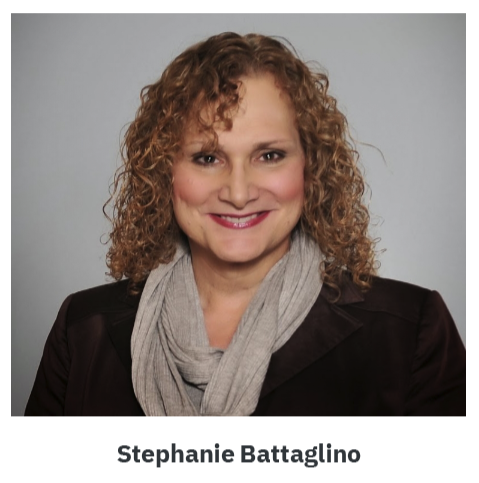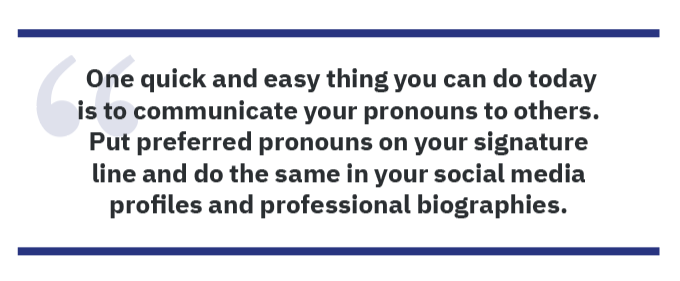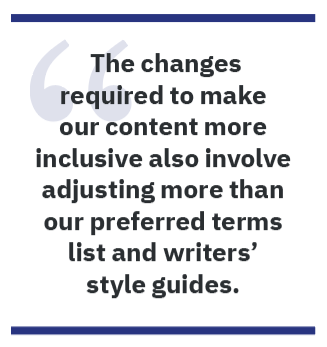By Scott Abel | STC Fellow
In this installment of “Meet the Change Agents,” I chat with internationally recognized, transgender motivational speaker and workplace diversity, equity, and inclusion consultant Stephanie Battaglino. We discuss the role of word choice when communicating with, to, or about transgender and gender nonconforming individuals. Battaglino’s honest and vulnerable storytelling will help you better understand the need for, confusion about, and impact of adopting inclusive language that recognizes and respects the identity of others.
This interview has been edited for clarity.

Scott Abel: Stephanie, can you tell our audience a little about yourself to set the stage for this interview?
Stephanie Battaglino: I am the founder and owner of Follow Your Heart, a consulting firm founded to help organizations educate, inform, and inspire by changing hearts and minds by sharing real-world personal stories of self-discovery.
I founded the company as my side hustle nearly a decade ago while working as a vice president at New York Life in Manhattan. I was the first person in the company’s history to come out and identify myself to my employer as transgender. I thought my decision would cause the company, a conservative, traditional-minded, brick-and-mortar firm, to run me out of town on a rail. But they didn’t do that. They didn’t fire me, which can be a typical outcome for many trans people in similar situations.
Surprisingly, the firm’s leaders asked me, “How can we make this transition as comfortable as possible for you?”
I used that opportunity to lead them by the hand, and we walked through it all, and it went very well. I remember saying to them, “Hey, look, I might be the first trans person to come out at this company, but I won’t be the last.” That’s when I realized a huge need for someone like me to help corporate leaders understand how their organizations can address diversity, equity, and inclusion issues. It was out of that experience that my side hustle, Follow Your Heart, started.
Abel: Your personal coming out experience led you to a new career focus. You share your lessons with us in your memoir, Reflections from Both Sides of the Glass Ceiling: Finding My Authentic Self in Corporate America. Can you talk to us about the book and how it came to be?
Battaglino: While the book is a memoir, it also includes stories from others. By focusing on effectively communicating what I learned — valuable lessons from the road — I’m hoping readers will discover my story and learn critical concepts and strategies I encountered along my journey.
Abel: Your stories make it easy for readers of all stripes to understand situations in which few will find themselves. Why did you write the book, and who were you hoping to reach? What were you hoping to achieve?
Battaglino: I started writing the book immediately after the Pulse nightclub massacre in Orlando. That domestic terrorism attack touched me, and the senseless loss of life pushed me to write the book. The massacre motivated me to reach out to people of all sorts, to touch their hearts, and to share stories about others so they might become more empathetic about people who are different.
Abel: What messages do you hope your book conveys to corporate leadership today?
Battaglino: One of the most significant value propositions my book offers corporate leaders is moving from policy to practice. Increasingly, companies are instituting diversity, equity, and inclusion initiatives; equal opportunity policies; and anti-discrimination protections that include trans and nonbinary people.
The policy stuff’s easy, but the challenge is getting the details right. My book offers corporate leaders guidance on how to influence the adoption of equity-focused policies that address corporate culture issues, including language usage, and a host of other business challenges and opportunities.
Abel: Authoring a book is a surefire way to discover new ways of viewing things. What did you learn from writing the book?
Battaglino: I realized I have a bigger story to tell. My account includes the chronicles of my origin and my revelations after coming out. The notion of reflections from both sides of the glass ceiling is my revelation that I no longer enjoyed the benefits of male privilege once I transitioned from male to female.
Abel: That’s an excellent segue to my next question. I had never thought about the glass ceiling issue post-transition. How could someone have privilege and then have it slip away? Wow! I didn’t even think that was a thing.
Talk to us about the title of the book. What does it mean?
Battaglino: I was in corporate America for 25 years before coming out, navigating the corporate space as a white guy. I was fortunate to have opportunities to move up the corporate ladder, which I did, stepping on the heads, toes, and shoulders of the women with whom I worked along the way. I was blind to all that. Moving forward and up the rungs of the corporate ladder was my focus. I didn’t realize it then, but my white male privilege made much of my success possible.
Of course, I didn’t know I had male privilege until I lost it. After transitioning, the way my co-workers treated me changed. They started questioning my ideas and decisions, even though my management style—and our corporate policies—hadn’t changed. Staff began calling me to task on all sorts of things.
I think my presence was disconcerting for some of the men in the room. It turns out I was working with some transphobic people. Caught off guard because my co-workers were generally accepting of my transition, it dawned on me that how people treated me had little to do with me being trans. It had everything to do with me being a woman in the workplace—a woman coming from a very different place than my cisgender female colleagues.
Abel: That discovery no doubt informs how you coach leaders looking to design more equitable workplaces. Our readers are information developers and technical communication pros responsible for developing clear, concise, and relevant product information. Adopting inclusive language is increasingly part of their purview. What is your perspective on inclusive language?
Battaglino: As organizations develop the capabilities to build more satisfying workplaces for an ever-diversifying talent pool, inclusive language plays an essential role.
Culture varies from company to company. Successful diversity, equity, and inclusion efforts are about people, their differences, their similarities, corporate culture, and how we communicate. Adopting inclusive language allows us to create a big tent for the ever-diversifying pool of talent out there looking to be hired by your company.
I think language choices are dependent on corporate culture. For organizations to become truly inclusive, cultural acuity is needed. It’s the ability to develop compelling insights in cross-cultural situations, even when the target culture is highly unfamiliar. Moving from diversity, equity, and inclusion policy to practice involves considering inclusive language adoption and working to eliminate non-inclusive terminology.
Inclusive language initiatives aim to meet people where they are. And these may be people like myself, like my trans and nonbinary siblings, that you may not have encountered before. You must have meaningful exchanges with us. We’ll go somewhere else if you can’t meet us where we are. Culture is where it all happens. The key components are communication and language.
Abel: Speaking of language, we used a term that might be unfamiliar to some of our readers earlier in this interview: cisgender. What does that word mean, and where did it come from?
Battaglino: We needed a word to describe people who are not transgender. Cis is Latin for same, and trans is Latin for across. So that’s where we come up with cisgender and transgender.
A person whose gender identity aligns with their birth sex—or the sex determined at birth—is cisgender. As a transgender woman, my gender identity is female, but my birth sex is male. Because there was an incongruity between my gender identity and my birth sex, I am considered transgender. We use the term cis in the vernacular, just like we use the word trans instead of transgender.
Abel: Focusing on pronoun usage is getting significant attention in organizations of all shapes and sizes around the globe. It’s a hot, and often contested, topic in business, education, government, and beyond. There’s significant movement in the conversation about respecting preferred pronouns. What should we know about using preferred pronouns, and why does this matter?
Battaglino: It matters because many people in the LGBTQI+ community desire to be heard, identified, and seen. A great, and relatively easy, way to do that is to respect the pronoun choices of others. For the uninitiated, that can be disquieting, and asking people to change how they use words introduces confusion and anxiety.
Connecting with someone is nearly impossible if we ignore their preferred pronouns. When talking about trans and nonbinary people, because they present themselves in a certain way, their gender expression may be difficult to ascertain or different than what an individual expects. And sometimes, especially amongst younger folks, they’re not in a place where they might necessarily know yet what pronouns they’d like you to use.
It’s not as complicated as some make it out to be. I’ve identified an easy-to-implement approach that will help you tackle this challenge head-on.
Let’s look at a practical example. Scott, if you and I were meeting for the first time, and you aren’t quite sure about who I am and what my gender is, the best way to approach that would be to use my name to address me, which avoids us having to worry about pronouns.
When the time comes, and you need pronouns, it’s best not to guess. The best practice is to ask. It’s as simple as “Stephanie, what pronouns do you prefer?”
Some folks like to take a proactive approach and declare their pronouns when they first meet you. Some workers have even taken to including their pronouns on their workplace name badge, just below their names.
When introducing yourself, feel free to share your preferred pronouns. You’re creating the space to have a meaningful conversation, and doing so tells the person on the receiving end of that communication that you see and respect them.
You might think, well, that’s no big deal, but it is a big deal. When you speak to someone like me and ask me about, and use, my preferred pronouns, I see you as respectful of me, and it shows me that you value our interaction.
Abel: Let’s talk about authentic intent. I bring this up because people struggle to adjust to changes for many reasons, especially when adopting more inclusive language.
Battaglino: Authenticity is an essential element in successful communication. People pay attention and hear you when you’re honest and straightforward, engendering confidence.
Intent, too, is central to effective communication. When people attempt to adjust their usage of certain words to become more inclusive communicators, they will slip up, accidentally reverting to less inclusive terms or unknowingly misgendering someone. It happens. But, it’s intent that matters.
We must demonstrate patience with people as they learn new word usage patterns and adjust to the quick-changing inclusive language landscape. They’ll make mistakes they never intended to make, and we should deal with them realistically and without hyperbole, as it’s a natural part of our culture and language evolution.
Abel: What suggestions can you share to help our readers better communicate with others while honoring individual differences?
Battaglino: One quick and easy thing you can do today is to communicate your pronouns to others. Put preferred pronouns on your signature line and do the same in your social media profiles and professional biographies. LinkedIn recently began including preferred pronouns as part of public profiles.
One company I work with starts out every meeting with introductions that include preferred pronouns. These are visible signs to individuals inside and outside the organization that a company’s culture leans toward being more inclusive.

Abel: It’s challenging for people to change how their brains think about language, especially when it’s habitual, like writing. For people who already know and understand how their native language works today, do you find that breaking those patterns may be easier for some people than others?
Battaglino: Yes. It’s more of a struggle for some folks than for others. It may sometimes be a generational thing, you know? I’m a baby boomer who thinks some of those ingrained patterns are perhaps more prevalent in my generation. The word transgender didn’t even exist when I was growing up during the ’70s and ’80s. Back then, we were referred to by others as transvestites.
But for younger generations, this evolution is happening in their workplaces, and cultural and social circles. Intergenerational differences aside, it’s essential to recognize that the proverbial train has left the station on this issue. Either you’re on the train, or you’re running after it. It would be best if you got on board to be relevant and capable of effective communication.
Abel: How do you distinguish between organizations that talk the talk but don’t walk the walk? Are there specific questions you can ask—or research available—to help us determine a company’s culture?
Battaglino: I host a video podcast called Walk the Walk, Talk the Talk, which I urge your readers to watch. Additionally, you can learn about corporate culture by reading a publication from the Human Rights Campaign called the Corporate Equality Index, which is considered the diversity, equity, and inclusion barometer for companies, particularly those listed in the Fortune 500.
Abel: Can you recall workplace situations where language impacted negatively or positively and a story that would help illustrate your points?
Battaglino: Here’s one involving me. I worked at the company for five years as my former self, Michael, before I came out as Stephanie. During that process, many people—well, many white males of a particular generation—would misgender me.
There was one instance where I got dead-named by a co-worker. For those who don’t know, being dead-named happens when someone refers to a transgender person by their birth name after changing their name as part of their gender transition.
I was born Michael, so for 25 years of my corporate career, I was Michael Batina. During one of my first meetings after transitioning, I was having a heated exchange with a white male colleague who was very accepting of me but, in the heat of the moment, called me by my birth name, Mike, and I was like, hold it, you know?
The poor guy regretted it as soon as he said it. He was noticeably embarrassed and ashamed of his choice of utterances, and he immediately apologized. I knew he didn’t intend to use my dead name because we had a good and long history of working together. In his brain, I was Michael. He had worked closely with Michael for years and, as such, identified me as a man. In the heat of debate, he unintentionally used my dead name.
I cut him some slack because he wasn’t trying to be malicious. We can use stories like mine as teaching moments to explain to people what’s happening so that they understand and that we move forward toward creating a more equitable world for us all.
Transgender folks must be sensitive to the fact that cisgender folks will make mistakes adjusting to these new pronoun guidelines and our desire for improvements in overarching terminology use. Mistakes are going to happen, and that’s fine. You don’t need to fall over yourself when you make an inclusive language faux pas. Apologize. You’ll do better over time. And we’ll all move on to more pressing issues, and that’s the key to moving things forward.
Abel: Thank you for sharing that. Your co-worker reacted reflexively—not trying to misgender or misidentify you intentionally. They acted passionately and in the moment. That’s why we must understand how other people use words in the context in which they’re using them.
Battaglino: You’re right about that. What I think is vital to notice in that interaction is that my co-worker was trying to wrap his head around what was happening to me. During a separate conversation, he asked me if I was “still like Mike on the inside?” I replied, “Of course I am. I’m just happier and more content. I am who I am, but my essence is still the same.”
 Abel: How are inclusive language initiatives impacting organizations attempting to improve their communication efforts?
Abel: How are inclusive language initiatives impacting organizations attempting to improve their communication efforts?
Battaglino: You might think adopting more inclusive language involves simple adjustments to our terminology. While that’s true, the changes required to make our content more inclusive also involve adjusting more than our preferred terms list and writers’ style guides.
There are computer system considerations—back-end database fields and system logic issues, deprecated terms in error messages, field name labels. Graphic user interfaces also introduce considerations. Forms are notorious for providing no way for people to identify themselves as they see fit. Medical and healthcare instructions often contain cumbersome, problematic terminology and gendered language.
Using nonjudgmental, non-stigmatizing, facts-based information and personal characteristics as descriptors, only when medically relevant, can improve the accessibility of medical content. Replacing male and female pronouns with the singular “they” is an excellent first step in the right direction.
Abel: This has been an educational and informative interview, Stephanie. Thank you for sharing your personal experiences, advice, and lessons learned with our audience. I appreciate it.
Battaglino: Thanks, Scott. It’s been my pleasure.
 In the digital age, change happens quickly. This column features interviews with the movers and shakers — the folks behind new ideas, standards, methods, products, and amazing technologies that are changing the way we live and interact in our modern world. Got questions, suggestions, or feedback? Email them to scottabel@mac.com.
In the digital age, change happens quickly. This column features interviews with the movers and shakers — the folks behind new ideas, standards, methods, products, and amazing technologies that are changing the way we live and interact in our modern world. Got questions, suggestions, or feedback? Email them to scottabel@mac.com.


